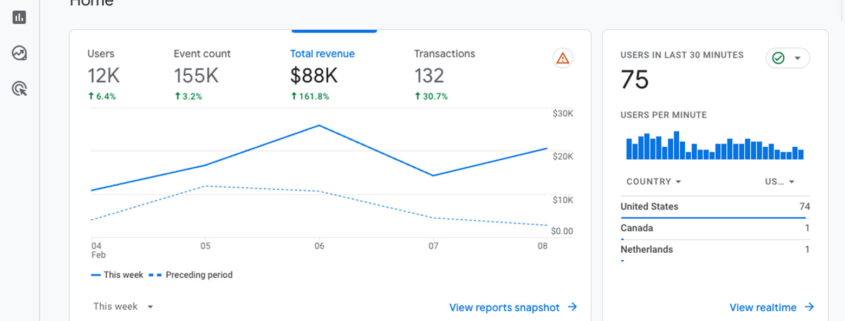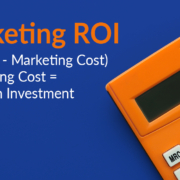What Can You Do With Marketing Analytics? Boost Your Conversion Rates!
You know the best marketing teams keep a constant eye on their data – but when you look at your own dashboard all it does is give you a headache. We get it.
Don’t worry, you’re not alone. Marketing analytics can be tough to understand – in fact, there are whole fields of study devoted to understanding them. But you don’t need to get your Masters in business intelligence to be able to use your data to boost your marketing initiatives. We have all the info you need to know right here.
Make the Most of Your Marketing Data
To put your marketing dollars to their best use, you need to use web analytics to guide your business decisions – but how?
The first step is to figure out what kind of data analysis is actually helpful to your marketing activities. Then, you can start turning those metrics into a higher return on investment.
KPIs: The Metrics You Need to Watch
Not all metrics are made equal – some are especially crucial when it comes to predicting consumer behavior.
Key performance indicators (KPIs) that are essential for generating a high marketing ROI include:
-
- Click-Through Rates: The number of clicks your ad receives divided by the number of times your ad is shown.
- Open rate: How much of your target audience opened your marketing emails.
- Conversion Rates: How many users took a desired action on your website compared to how many visited.
- Customer Lifetime Value: the total amount of money a buyer has spent with your business throughout their customer journey.
- Bounce Rate: the number of visitors who land on your website and leave before taking any other action.
- Time Spent on Page: how long someone spends on a web page before moving on to another.
- Visitor Demographics: information about the visitors to your website/ the followers of your social media pages, such as ethnicity, age, gender, income, etc.
- Traffic Sources: Using Google Analytics, you can determine how many of your visitors are coming from your paid ads, organic searches, or referral sources.
- Engagement: If social media is part of your marketing mix, pay attention to how many likes, comments, and shares you get – and when you get them.
Problems Data Analytics Can Solve
These KPIs give you actionable insights into which of your marketing decisions were wins and which weren’t so great.
For instance, if you’re getting tons of likes and shares on Facebook compared to Linkedin, you may need to reconsider if LinkedIn is the right marketing channel for you or if you need to readjust your messaging for that platform’s demographics.
If you notice that customers don’t spend much time on your page, you want to take a look at how well you’ve designed your web pages. Do they provide a positive user experience? Do they promise something other than what they provide?
High bounce rate and low conversions? Then you may want to take a look at your CTAs. You want these to be above the fold, and you want them to be direct, compelling, and come with a sense of urgency.
Does all your traffic come from paid sources? You may want to up your SEO game. While paid ads can be a great way to boost brand awareness and push your product in the short term, a long-term SEO strategy will yield the greatest marketing ROI over time.
If there’s a regression in your marketing performance, keeping an eye on your metrics can help you determine when it began – which can help you determine what you started doing differently that isn’t working.
How to Use Data-Driven Decisions to Drive Your Digital Marketing
Knowing what’s worked and what’s flopped is important for successful decision-making. But you shouldn’t just be looking back at your previous marketing performance, you should actively collect and work with real-time metrics.
Conducting A/B testing of emails and ad copy can help you hone in on what strategies resonate best for your target audience. Content that your customers respond well to needs to be front and center when designing your ad campaigns.
It’s equally important to know where your customers are and when. It’s important to keep track of the various touch points that customers use to access your landing pages and monitor where you get the most engagement. This helps you determine how much of your marketing dollars to invest in PPC ads on various platforms.
Finding the Right Marketing Analytics Tools
That all sounds great, but it’s hard to aggregate data all on your own AND then have to do the decision-making based on the findings.
Luckily, machine learning automation and analytics software can help you out there.
Google Analytics
As we mentioned earlier, you want to make sure that you’re using Google Analytics. It gathers data from all of your websites and creates reports about who’s been coming to your page, from where, and for how long.
Hootsuite
Hootsuite is a great resource for monitoring your social media ROI – it uses data to recommend the best posting times, help you repurpose your top-performing content, and even let you know how well your performance stacks up against your competitors.
HubSpot
HubSpot is a CRM platform that uses powerful AI tools to automate data analysis to give you actionable insights into your consumers’ behaviors and their lifespan as well as the performance of your marketing campaigns and can even assist in drafting content.
Maximize Your Marketing Strategy
Ready to optimize your marketing efforts and dig into some data?
Or does it still sound like a little much? After all, while AI can help automate your data and its findings – it still can’t tell you what to do with it. That takes the creativity of a human brain (for now).
We can help you out. Not only can we make sense of all the KPIs, but we also know how to take all that data and turn it into winning digital marketing strategies. If you really want to excel in today’s ever-changing digital marketplace, reach out today. We’ll take your marketing efforts to the next level.












